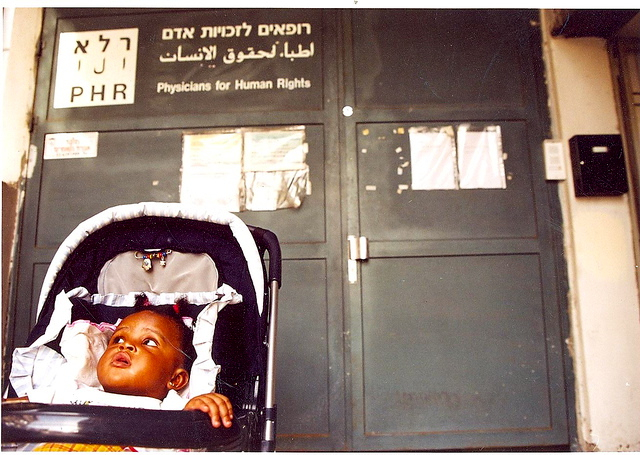Imagine you lived in an impoverished area with virtually no hope for the future. It’s a place where there is little work to be had and your family struggles every day to keep a roof over their heads and find some food to eat.
Then imagine you have an opportunity to go abroad, either to get a degree at a prestigious university or for a really good job that would allow you not only to have a better life, but also to send significant assistance back to your family.
Then imagine that, by taking advantage of that opportunity, you lost your citizenship and could not return home. Over a quarter of a million Palestinians since 1967 have not had to imagine it. They simply lived it.
The Israeli human rights organization, HaMoked, filed a freedom of information request and got the figures from the Israeli Ministry of Defense. The report covered the years 1967 to 1994, when the Palestinian Authority was created.
The implication is that such practices stopped then, as the PA administered civil authority. But B’Tselem reports that the practice continues in East Jerusalem. The high water mark for revoking residency there was reached in 2008, when 4,577 Palestinians lost their residency rights.
This is not news to anyone who has worked with Palestinians, and it is an issue that has been raised not only in that sector but also by Israeli and other human rights organizations for years. The only real story is that Israel has admitted to at least part of the program.
And the name of that program is Get Rid of the Non-Jews.
This is the same attitude that is so visible today with the frightening hostility to refugees who have sought shelter in Israel from potentially life-threatening conditions in their home countries.
One need look no further than Israel’s Minister of the Interior, Eli Yishai, to see the personification of the xenophobic hate that has gripped so many Israelis.
“This is not an operation against the infiltrators (sic),” Yishai said, “But a campaign to preserve the identity of a Zionist Jewish state.”
The term “infiltrator” has an ugly history in Israel, as it was used to refer to Palestinian refugees, whether or not they actually tried to get back to their homes, in the early days of the state. It reflects a base hatred and fear of non-Jews that has always been part of Israel’s character, to some extent for understandable reasons, but which has lately risen to an ugly prominence.
No doubt, many will say that this is the inevitable result of Zionism. And, indeed, the Zionism of Yishai, Benjamin Netanyahu and Avigdor Lieberman certainly does bear out such a view, just as the bureaucratic sleight of hand that barred a quarter of a million Palestinians from returning to their homes after time spent abroad to better themselves shows that the attitude has long been present.
Even in the 1948 war, while many nascent Israelis were not in favor of expulsion, the leadership under David Ben-Gurion certainly encouraged Palestinian flight and expelled many Palestinians directly, barring their return after the war and creating the refugee crisis.
Is this what Zionism had to be?
I think not. I do not believe that a Jewish home in Palestine necessitated the demographic obsession that has led to all of these events. But that obsession did take hold of Zionism, on both the left and right wings of it.
And it’s time now to break that hold.
Zionism, like any nationalist movement, is self-focused and privileges its own members over other people. This is endemic to nationalism, and gets magnified when a nationalist movement succeeds and attains state power. When that nationalist movement is engaged in ethnic conflict, the magnification increases exponentially.
That’s been the case since the advent of modern nationalism. But in the 21st century, we have an expectation that such nationalist movements eventually come to terms with that built-in bigotry and move toward a more egalitarian approach to other peoples.
Sadly, Israel seems very much to be heading in the opposite direction.
The violence in South Tel Aviv is not the result of a small, xenophobic minority. A poll by the Peace Index found that 52% of Israeli Jews agreed with Likud MK Miri Regev who called the African refugees a “cancer.” And 1/3 of Israeli Jews went so far as to say they could “identify” with the violence against the refugees (a smaller minority of 19% of Palestinian citizens of Israel also agreed with Regev.) That’s a minority, but a significant one.
One can certainly argue that many people holding these views do so out of economic stress and the fear of the refugees that has been fired up by too many Israeli leaders.
But Yishai’s view, and the paucity of outcry against it, tells a different story. The notion that a few thousand refugees could threaten the “Jewish character of the state” demonstrates a level of paranoia that is astounding.
But perhaps it is to be expected. The obsession with a Jewish majority was understandable, if not condonable, in 1948. The conflict was raging, the fledgling state of Israel faced uncertain prospects, and even the United Nations had come up with a partition plan that strove for a Jewish majority on one side and an Arab majority on the other side of Palestine.
But the fact of the matter is that notions of a Jewish majority in Palestine for the early Zionist leaders of the Mandate era, were based on the dream of massive Jewish immigration. Consider, for example, the words of the father of the Israeli right wing, Ze’ev Jabotinsky:
First of all, I consider it utterly impossible to eject the Arabs from Palestine. There will always be two nations in Palestine – which is good enough for me, provided the Jews become the majority… I am prepared to take an oath binding ourselves and our descendants that we shall never do anything contrary to the principle of equal rights, and that we shall never try to eject anyone. This seems to me a fairly peaceful credo.
Jabotinsky was focused on one thing: Jewish immigration to Palestine, what one might call “positive demographic” thinking, despite his militancy and fascist insistence on forcing the Palestinians to accept Jewish rule in Palestine.
It was really Britain’s Peel Commission that gave birth to the idea of “transferring” Palestinians (and some Jews as well) in a partition plan, creating the notion of “negative demographic” models. This idea was embraced by David Ben-Gurion and, crucially, by Josef Weitz, a major player in the pre-state Yishuv and the Jewish National Fund (JNF).
Jabotinsky was convinced that the Zionist movement could bring enough Jews into Palestine to ensure a Jewish majority. Despite the trauma of the Holocaust and the flight and expulsion of most of the Jews of the Arab world, he was proven wrong.
Rather than accept this reality, Israel has turned to ongoing expulsion and xenophobia.
A Jewish majority, even if one considers that a worthwhile goal, is not worth the price in the suffering of Palestinians and others and the moral rot of both Israel and the many Jews worldwide who feel connected to that country.
Nor is it necessary. There are other ways to fulfill the Zionist dream of self-determination, and the ability for Jews to defend ourselves, if it should be necessary in the future.
Instead of this demographic obsession, Israel could turn to a constitutional future, wherein Israel grants real equality to all of its citizens and guarantees, instead of the current Law of Return, that Israel will be a haven for Jews and Palestinians facing persecution in other countries. It could acknowledge Israel as the home of both the Jewish and Palestinian peoples whose identities were forged there.
The current state of Israel, whatever one thinks about it, was built by the Zionist movement. If it can stand on humanistic, rather than ethnocentric legs, it can continue to have a “Jewish character” no matter the demographics. Indeed, that character can be enhanced, as Jewish communities are and have been all over the world, by its interaction with others.
But it cannot achieve that sort of bright future, much less peace or substantive security, through xenophobia that causes it to turn its back on desperate people (as happened to the Jews during the Holocaust) or by using bureaucratic trickery to artificially maintain a preferred demography, a strategy which is no better than striving for “ethnic purity.”
Both the experience of the Palestinians who lost their residency, and the African refugees facing the ugliest kind of hate today, show a bigotry in Israel that cannot be explained by war or terrorism, much less by anti-Semitism.
It’s just plain bigotry. Such self-serving prejudice might have been understandable, again if not condonable, in the late 1940s. But today, it is simply unacceptable.
Both for the victims of that bigotry and for Israel, it has to be stopped.
Photograph courtesy of Physicians for Human Rights – Israel. Published under a Creative Commons license.






You write:
“It was really Britain’s Peel Commission that gave birth to the idea of “transferring” Palestinians (and some Jews as well) in a partition plan, creating the notion of “negative demographic” models. This idea was embraced by David Ben-Gurion and, crucially, by Josef Weitz, a major player in the pre-state Yishuv and the Jewish National Fund (JNF).”
While this may be true, it’s important to point out that Zionists and Yishuv leaders had been discussing the idea of “transfer” long before the 1937 Peel Commission. The evidence for this is quite well documented (see in particular, the book, “Expulsion of the Palestinians: The Concept of Transfer in Zionist Political Thought, 1882-1948” by Nur Masalha.)
Some examples: Theodor Herzl, in a 1895 journal entry, famously wrote:
“We shall try to spirit the penniless population across the border by procuring employment for it in transit countries while denying it any employment in our own country.”
British Jewish leader Israel Zangwill said in 1905:
“We must be prepared to drive out by the sword the (Arab) tribes in possession as our forefathers did or to grapple with the problem of a large alien population…accustomed for centuries to despise us.”
Labor Zionist leader Nahman Syrkin in 1898:
“Palestine, thinly populated, in which the Jews constitute today 10 percent of the population, must be evacuated for the Jews.”
More significantly, Chaim Weizmann (then President of the Zionist Organization and the newly established Jewish Agency Executive), spearheaded a secret transfer plan (known as the 1930 Weizmann-Rutenberg Plan) that was presented to the British Colonial Office, proposing the raising of funds to “resettle” Palestinian peasants to Tranjordan and Iraq. At roughly the same time, Menachem Ussishkin, chairman of the JNF and member of the Jewish agency Executive, stated publicly to journalists:
“We musts continually raise the demand that our land be returned to our possession…If there are any other inhabitants there, they must be transferred to some other place. We must take over the land. We have a greater and nobler ideal than preserving several hundred thousands of Arab fellahin.”
I bring up these examples because I believe it is enormously important to understand that the idea of ethnic cleansing was part of Zionist discourse from the beginning – well before 1948 or even 1937. While Ben-Gurion and Yishuv leaders may have publicly accepted the idea of partition into states with “negative demographic models” they also knew full well that Palestinians would never accept such an “offer” – thus their plans for eventual transfer continued apace.
I think we dance around the issue when we try to prove Israel is somehow an “Accidental Empire” or that events simply conspired to bring us to this point today. Zionism at its core was a movement that wanted to create a ethnically Jewish state in a land that contained an overwhelming majority of non-Jews. It is natural and understandable that the idea of transferring out non-Jews would be inherent to the Zionist idea from its origins.
I also bring up this history because I believe it puts current events in context. In a sense, these transfer plans continue to unfold and evolve before us as Palestinians are subjected to draconian laws that aim to either force them to emigrate or else move to de facto Bantustans in Areas A and B in the West Bank. At the end of the day, transfer is still very much at the heart of the institutional Zionist project, regardless of the best intentions of Liberal Zionists in Israel and abroad.
Brant, I would say that your last sentence is pertinent, but also inaccurate. “Liberal Zionists” is a difficult term, and for most, it would encompass Ben-Gurion, Shimon Peres, and Weizmann, for instance. Presuming that’s not what you mean with the term, it is important to understand Masalha’s excellent work in context.
Many of the early Zionist writings were extremely speculative. More complete readings of them than Masalha’s book was intended to encompass, find them exploring many possibilities, not because these men were uncomfortable with transfer, but rather that their thinking was very long term. Herzl and Syrkin never dreamed there would be a Jewish state in a mere five decades from when they were writing.
The Peel Commission recommendations did not come out of the ether, they were based on discussions that started in Britain, with Zionist involvement, in the late 1920s.
But Zionism is very difficult to pin down as “essentially” anything “at its core,” because its early days were largely speculative and that speculation was all over the map. Naturally, anti-Zionist writers will emphasize the worst of political Zionism, while apologists for Zionism will emphasize the humanism of cultural Zionism. In practice, of course, the cynical and more ethnocentric political version won out over the more egalitarian cultural one. But this was far from clear at the beginning of the movement, in the early days of the 20th century.
As to the notion of an “accidental empire” it is neither the case that the birth of Israel with its attendant dispossession and denial of rights to Palestinians was a mere confluence of events, nor the case that the events that have occurred were all engineered, planned for or even anticipated by the Zionists/Israelis.
One very important point regarding a forward vision is that Israel and the Zionist movement bears primary, but very far from sole, responsibility for the state of affairs today or in the past. The list of entities that helped bring about the current situation is long. It includes the US, UN, League of Nations, Britain, France, the USSR/Russia, Transjordan/Jordan, Egypt, Syria, Turkey, Iran, the Arab League more generally, and, yes, the Palestinians themselves (see Rashid Khalidi’s The Iron Cage for the best explanation of this last). While in more recent years, one might say some of these entities were pressured by an Israel Lobby, that’s an implausible excuse for the early days.
All of those entities owe a debt to the Palestinians, and they all have a responsibility to be part of the solution. Not as much as Israel does, to be sure, but the current status quo could not have come into begin without the actions of many parties, not just Israel, and very few of those actions were any more “accidental” than Israel’s.
Moreover, I submit that our job is a lot harder if we contend that Jewish nationalism, ipso facto, must be so intensely racist as the transferrists of then and now display it to be. I make the case instead in this piece that a more humanistic and universalist view can be expressed, where the presence of others, even if they constitute a numerical majority, and maintaining equal rights in every sense for all can not only be a viable and more ethical path, but also a realistic one that actually strengthens Jewish self-determination.
yes, I believe that makes finding a solution more possible because it takes away the zero-sum equation where Palestinian rights are seen as negatively impacting Jewish self-determination, even by liberals. But I also make the case on practical terms that this can be done. In other words, yes, I find it a preferable belief, but I think it is also a more realistic one.
We live in a world where it’s hard to get anything worthwhile done. Prayer and hand-wringing are not effective, but what is? Asking Israel to voluntarily change its stripes — as this article seems to do — is like asking the tiger to do the same. Ain’t a-gonna happen (unless, of course, there is sufficient outside pressure, in which case, Israel might respond to pressure but could hardly be said to be the initiating actor — or to be acting voluntarily).
Outside pressure is the sine qua non to making any change in I/P; otherwise the status quo 1SS (apartheid, non-democratic, overflowingly abusive) will continue, as will the Israeli usurpation of land and water — and the gradual expulsions.
All people of goodwill should get behind BDS (full-Israel BDS, mind) understanding it as a precurser to nation-state-level action of a similar cast, all to the end of enforcing well-stated international law and agreements by requiring Israel to remove all the settlers, remove all the settlements and the wall, end the siege, and ultimately end the occupation (itself arguably illegal, after 45 years, as a permanent taking of land by threat and use of force), and make some provision for the refugees.
NB: unless I/L requires countries to be democratic or non-discriminatory, I do not believe that the BDS and BDS-like actions I propose above should require that Israel become either democratic or non-discriminatory; in any case, to be fully democratic, in my view, Israel would have to readmit all the refugees including those living in Gaza and WB as full, voting citizens. As to democracy and non-discrimination and full RoR, I believe the Palestinian-BDS formulations go too far, although I am in entire sympathy with their desires. Enforcing I/L is enough for me.
Is a call for nation-state BDS pie-in-the-sky? Sure, but less so than asking Israel to change its stripes.
Saying “Asking Israel to voluntarily change its stripes — as this article seems to do — …” must make one wonder what article you read. I gather you accidentally posted this comment here referring to something else.